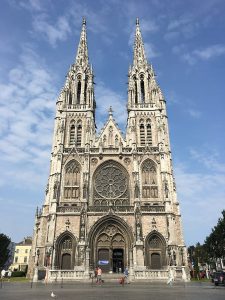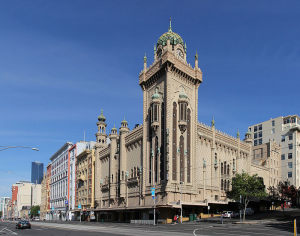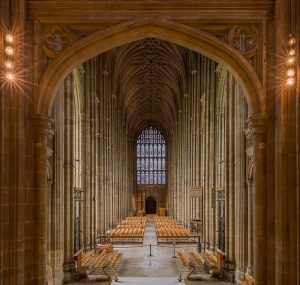Gothic Architecture
Gothic architectural design was developed as a progression from Norman architectural form. The Gothic period is commonly considered to extend from the mid-12th Century through to the 16th Century, when Renaissance architecture began to replace Gothic design. Gothic architecture is largely confined to northern Europe, particularly France, Germany and the UK.

Church of Saint Peter and Saint Paul (Sint-Petrus-en-Pauluskerk van Oostende) by architect Louis Delacenserie. Manuelarosi / CC BY-SA
The defining feature of a Gothic structure is the pointed arch. This supersedes the Norman arch, which had a curved top. Other Gothic features include: flying buttresses (stone structures which help to support the main building); vaulted ribs; and stained glass windows.

The Forum Theater, Melbourne by architect John Eberson. Donaldytong / CC BY-SA
Learn about Melbourne Gothic icon, The Forum Theatre.
Ornamentation is a key component of Gothic style. Many Gothic structures are heavily ornamented, with gargoyles, statues and sculpted stone all commonly seen. Gothic structures are constructed almost exclusively of stone, wood, mortar, glass and cement – the most durable building materials found at the time. The Gothic structures which have survived are almost invariably churches or cathedrals.

The nave of Canterbury Cathedral by architect John Wastell. Diliff / CC BY-SA
There are numerous examples of stunning Gothic architecture still standing today. These include: Cologne Cathedral, Cologne, Germany; Chartres Cathedral, Chartres, France; the Basilica of Saint-Denis, Paris, France; Canterbury Cathedral, Canterbury, UK; Amiens Cathedral, Amiens, France; the Black Church, Brasov, Transylvania; Frankfurt Cathedral, Frankfurt, Germany; and St Stephen’s Cathedral, Vienna, Austria.
Cover Image of Cathedrale Salisbury Interieur by Bernard Gagnon / CC BY-SA





